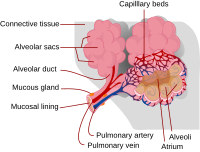
Photo from wikipedia
OBJECTIVE To measure changes in pulmonary perfusion during pulsed inhaled nitric oxide (PiNO) delivery in anesthetized, spontaneously breathing and mechanically ventilated ponies positioned in dorsal recumbency. ANIMALS 6 adult ponies.… Click to show full abstract
OBJECTIVE To measure changes in pulmonary perfusion during pulsed inhaled nitric oxide (PiNO) delivery in anesthetized, spontaneously breathing and mechanically ventilated ponies positioned in dorsal recumbency. ANIMALS 6 adult ponies. PROCEDURES Ponies were anesthetized, positioned in dorsal recumbency in a CT gantry, and allowed to breathe spontaneously. Pulmonary artery, right atrial, and facial artery catheters were placed. Analysis time points were baseline, after 30 minutes of PiNO, and 30 minutes after discontinuation of PiNO. At each time point, iodinated contrast medium was injected, and CT angiography was used to measure pulmonary perfusion. Thermodilution was used to measure cardiac output, and arterial and mixed venous blood samples were collected simultaneously and analyzed. Analyses were repeated while ponies were mechanically ventilated. RESULTS During PiNO delivery, perfusion to aerated lung regions increased, perfusion to atelectatic lung regions decreased, arterial partial pressure of oxygen increased, and venous admixture and the alveolar-arterial difference in partial pressure of oxygen decreased. Changes in regional perfusion during PiNO delivery were more pronounced when ponies were spontaneously breathing than when they were mechanically ventilated. CLINICAL RELEVANCE In anesthetized, dorsally recumbent ponies, PiNO delivery resulted in redistribution of pulmonary perfusion from dependent, atelectatic lung regions to nondependent aerated lung regions, leading to improvements in oxygenation. PiNO may offer a treatment option for impaired oxygenation induced by recumbency.
Journal Title: American journal of veterinary research
Year Published: 2022
Link to full text (if available)
Share on Social Media: Sign Up to like & get
recommendations!